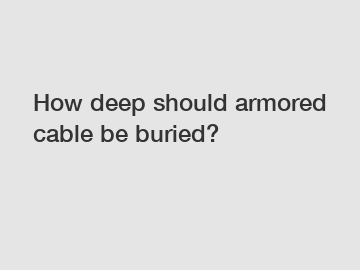How deep should armored cable be buried?
Ensuring the safe and efficient installation of armored cables is paramount when it comes to both residential and commercial electrical projects. One of the critical factors that demand attention during cable installations is the depth at which the armored cable should be buried. Determining the appropriate depth is pivotal to prevent damage, maintain functionality, and adhere to industry regulations. In this comprehensive guide, we will explore the key considerations and provide recommendations for burying armored cables at the optimal depth.
1. Understanding Armored Cables.
Armored cables, also known as MC (Metal Clad) cables or BX cables, are designed to offer enhanced mechanical protection compared to traditional non-armored cables. These cables consist of electrical conductors encased in a flexible metallic covering, which safeguards them from mechanical stress and external elements. The armor of the cable plays a crucial role in ensuring long-term durability and safety.

2. Why Bury Armored Cables?
Burying armored cables provides several benefits, such as protection against potential damages caused by environmental factors like moisture, rodents, physical impact, and accidental digging. By burying the cables, we safeguard them against these potential hazards, extending their lifespan and reducing the need for frequent repairs or replacements.
3. Factors Determining the Depth.
Several factors should be taken into consideration when determining the ideal depth for burying armored cables:
a. Frost Line: The frost line represents the maximum depth to which ground frost penetrates. It is essential to bury armored cables below the frost line to prevent any disruption due to freezing, expansion, or contraction of the ground.
b. Local Regulations: Compliance with local building codes and regulations is crucial in ensuring the safety and reliability of electrical installations. Each jurisdiction may have specific requirements regarding the minimum depth for burying armored cables, reflecting the region's climate, soil conditions, and potential hazards. Always consult with local authorities or a licensed electrician to ensure compliance.
c. Environmental Factors: Consider the impact of environmental conditions such as soil composition, moisture levels, and freeze-thaw cycles. These factors can affect the stability of the ground, which in turn may influence the depth at which the armored cables should be buried.
d. Adjacent Infrastructure: Take into account any existing infrastructure or utilities, such as gas lines, water pipes, or drainage systems. Maintaining a safe separation distance between armored cables and these utilities is crucial to prevent interference or accidental damage.
4. Recommended Depths for Burying Armored Cables.
While depth recommendations may vary depending on local regulations and conditions, the following guidelines are generally considered as best practices:
a. Residential Installations: For residential applications, such as underground service cables connecting your house to the main power source, it is typically recommended to bury armored cables at a minimum depth of 18 inches (45 cm) below the ground surface. However, in regions with frost penetration, the depth should be increased to 24 inches (60 cm) or more, below the frost line.
b. Commercial and Industrial Installations: In commercial or industrial settings, where a higher degree of protection is often required, the recommended minimum depth is commonly set at 24 inches (60 cm). However, deeper burial may be necessary for specific applications or if local regulations demand it.
It is crucial to note that these are general recommendations, and local regulations should always take precedence. Consulting a licensed electrician or authorities in your area will provide the most accurate information regarding the appropriate depth for burying armored cables.
Conclusion.
When undertaking electrical projects involving the installation of armored cables, the depth of burial should be given careful consideration. Adhering to the recommended guidelines, local regulations, and taking various factors into account will help safeguard the cables against potential hazards, ensuring their longevity and uninterrupted functionality. Remember, when it comes to electrical installations, it is always best to seek professional advice from licensed electricians and follow recommended guidelines to ensure safety and compliance.
Want more information on wholesale armored power cable, flexible power cable, 26/35kv steel wire armored cable? Feel free to contact us.

Comments